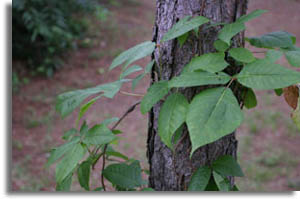| August 16, 2006
 Little
Rock, Arkansas - For most Arkansans, poison ivy ranks right up
there with the three uglies of outdoors – ticks, chiggers and
mosquitoes. They don’t like it, they are afraid of it, and they don’t
want to be anywhere around it. Little
Rock, Arkansas - For most Arkansans, poison ivy ranks right up
there with the three uglies of outdoors – ticks, chiggers and
mosquitoes. They don’t like it, they are afraid of it, and they don’t
want to be anywhere around it.
In reality, poison ivy is nearly everywhere – deep woods, rural
roadsides, mountains, creek banks and in cities. People who spend
much time outdoors on their jobs or hiking, hunting, canoeing usually
learn to both recognize and avoid poison ivy.
Many on the Arkansas
Game and Fish Commission staff deal with poison ivy – and avoid
it – daily in their work.
To others who get outside for picnics or just rambles in the woods,
the old saying of “leaves of three, let it be” can be a reminder, but
not a foolproof one. Poison ivy has three leaves in a cluster. But
its danger is more widespread, more insidious.
Brush against a poison ivy plant, and you are likely to wind up with
a highly irritating rash. The plant leaves a sticky substance called
urushiol, and it is potent. Medical experts say that roughly seven of
every eight persons are allergic to poison ivy, some much more than
others.
But brushing against the plant in the outdoors is far from the only
chance of being affected. Others are more difficult to handle and
avoid. A pet, a dog or cat, runs through poison ivy then you pet Fido
or Fluffy. The pet isn’t affected, but just a tiny bit of that
urushiol stuff on your hands can start unpleasant happenings. Pet the
dog that has just come in from the edge of some woods then rub sweat
from your eyes. Uh-oh – big trouble. Or scratch assorted places on
your skin, and there’s more trouble.
Shoes are notorious culprits for causing poison ivy attacks. You step
on a poison ivy plant and don’t know it then pull off the shoes that
night, and trouble follows.
First bit of action after an outdoors venture: Bathe thoroughly. If
you know you’ve encountered poison ivy, use cold water and sponge off
the spot. Hot water expands pores, letting urushiol seep in more
readily.
When the itchy rash appears, treat the spot quickly with calamine
lotion or Caladryl. Taking a Benadryl tablet may reduce the itching.
Cortisone creams help many people. Severe cases may require a
doctor’s attention and medication by injection.
Myth: “I can walk within six feet of poison ivy and I get the rash.”
No, it’s by contact. Urushiol doesn’t jump through the air.
Myth: Scratching the rash or popping the blisters spreads poison ivy
all over the body. No, the fluid inside the blisters is not urushiol.
But scratching with fingernails can certainly lead to infection.
Myth: “When it’s dry this fall, I’ll burn those poison ivy plants to
get rid of them.” Bad idea. Burning releases urushiol in the smoke,
and you can breathe it in as well as get it in your eyes.
Myth: “I’m not afraid of poison ivy, but poison oak and poison sumac
really affect me.” You’re talking about the same thing. The term
poison ivy covers several noxious plants, all of the sumac family.
Myth: “I’ll wait until the leaves are gone this fall then pull out
the poison ivy vines.” Another bad idea. Urushiol is also in the vine
stems and in the roots. Poison ivy produces small cream-colored
berries which birds love but these have that urushiol also.
Carefully use tools like a hoe, rake or shovel to kill poison ivy
plants then wash off the tools. Chemicals, herbicides, are available
also. But be careful. Use gloves. Source:
Arkansas Game & Fish
Commission
|